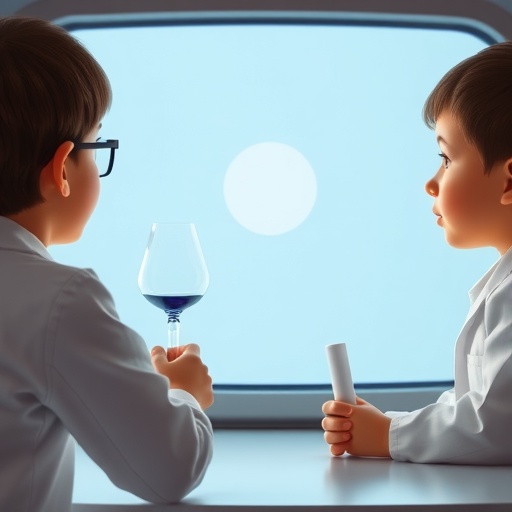In the realm of scientific communication and public perception, few topics command as much scrutiny as how children view scientists, especially in an age saturated with media. A groundbreaking study from The Ohio State University unveils fresh insights into children’s trust in scientists, specifically examining how superhero television shows, often featuring villainous researchers, influence this critical perception. Contrary to longstanding beliefs, children predominantly hold a positive view of scientists, and the feared “mad scientist” stereotype’s influence on young minds might be less pervasive than previously assumed.
The extensive research involved 256 children between the ages of 8 and 12 and assessed their baseline trust in scientists across three key dimensions: expertise, integrity, and benevolence. Using carefully structured surveys, the children were asked to evaluate whether scientists were “smart” or “dumb” and to rate how much they trusted scientists to be knowledgeable, honest, and well-intentioned. Remarkably, nearly all participants rated scientists as intelligent, attributing high scores to their expertise, while slightly lower—but still positive—ratings were given for integrity and benevolence. This nuanced understanding suggests that children distinguish expertise from moral qualities when conceptualizing scientists.
This study diverges from earlier research methodologies that relied on children’s drawings to extrapolate their perceptions of scientists. Previous findings—often cited to suggest children see scientists as malevolent or eccentric figures—may have conflated the imagery of memorable villainous characters from popular culture with genuine beliefs about scientists. By directly querying children rather than interpreting illustrations, this research offers a more robust and direct measurement of their epistemic trust in the scientific community.
To probe the impact of media further, the researchers utilized two distinct five-minute video clips from the animated series “Marvel’s Spiderman.” One clip featured a villainous female scientist engaged in nefarious activities explicitly linked to her scientific work, while the other presented a heroic female scientist as a positive role model. The choice of a female scientist character was deliberate, aiming to challenge ingrained gender biases about scientists traditionally perceived as male. This design allowed for evaluating how children’s existing attitudes—or the absence thereof—shape their interpretation of scientists’ actions when depicted in media.
The results indicated that children’s trust in scientists only diminished measurably when the negative behaviors of the villainous scientist were explicitly associated with science or the label “scientist” was directly invoked. When references to the character’s scientific identity and activities were removed, children’s trust levels remained stable, effectively immune to the influence of her villainous actions. This suggests that, for young audiences, causally linking scientific endeavors with unethical behavior is pivotal in shaping trust.
Even so, the decline in trust observed when villainy was clearly attributed to scientific actions was modest at best. Importantly, children exposed to these portrayals did not equate scientists collectively with evil or malicious intent. Rather, they expressed a slight hesitation or reservation in attributing positive qualities to scientists, indicating a nuanced rather than wholesale alteration of their trust framework. This subtlety highlights children’s capacity to compartmentalize fictional narratives from their broader, real-world conceptions of scientists.
Interestingly, children who viewed the heroic female scientist did not show a corresponding increase in their trust in scientists. The researchers explained that this ceiling effect likely stems from the generally high baseline trust levels children already possessed, giving minimal room for upward movement. This finding challenges assumptions that positive depictions inherently generate increased enthusiasm or belief in scientific integrity, emphasizing the importance of understanding pre-existing attitudes.
The study also incorporated parental data regarding their children’s exposure to superhero television programs. Findings revealed a weak correlation whereby children consuming higher volumes of such media demonstrated slightly reduced perceptions of scientists’ benevolence. While this effect was small, it underscores the subtle influence that media consumption patterns can have on children’s worldviews and trust in epistemic authorities.
One intriguing dimension of this research lies in distinguishing between stereotype activation and real belief. Children’s mental images of scientists—often shaped by culturally entrenched tropes such as the “mad scientist”—may persist in artistic or imaginative tasks like drawing but do not necessarily translate into their genuine trust or respect for the scientific profession. This disjunction invites deeper investigation into how media literacy and critical thinking develop during childhood.
The practical implications for content creators and educators are compelling. The study suggests that a simple editorial choice—avoiding explicit labeling of villainous characters as scientists or detaching unethical actions from scientific conduct—can protect children’s trust in actual scientists. Such measures have the potential to mitigate inadvertent negative messaging while retaining engaging storytelling.
Moreover, this research challenges the scientific communication community to reconsider how stereotypes are perpetuated and addressed at formative stages. Encouraging direct dialogues with children about science and scientists, rather than relying solely on indirect measures, provides a clearer picture of their perceptions and can inform strategies to foster well-rounded, accurate understandings.
In conclusion, the relationship between children’s media consumption and their trust in scientists is complex but predominantly resilient. Despite the occasional appearance of villainous scientists on popular superhero shows, children maintain an overall positive and nuanced trust in the scientific community. Small adjustments in media narratives can further safeguard these trust levels, ensuring the next generation continues to view science and scientists as pillars of knowledge and integrity.
Subject of Research: Influence of superhero television on children’s epistemic trust in scientists
Article Title: Mad Scientists, Bad Impressions? The Influence of Superhero Television on Children’s Epistemic Trust in Scientists
News Publication Date: 27-Oct-2025
Web References: http://dx.doi.org/10.1027/1864-1105/a000497
References: Journal of Media Psychology
Keywords: children’s trust in scientists, superhero television, mad scientist stereotype, epistemic trust, science communication, media influence on children, scientist perception, media psychology




